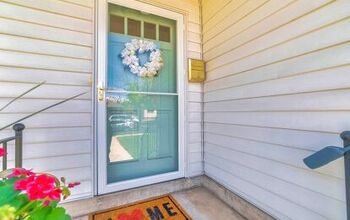How To Measure For A Sink Grid (Quickly & Easily!)

Sink grids, sometimes referred to as sink racks or basin racks, can be a great accessory to install in your kitchen sink. Although stainless steel sinks have an incredibly long lifespan, everyday wear and tear can cause them to dull over time. Using a grid can help, but it’s essential to measure for a sink grid properly.
To measure for a sink grid, you need the width and depth of the sink plus the measurements from each side of the sink to the drain. Use a tape measure to measure from one side of the sink to the other, just above where the walls start to curve toward the bottom of the sink. Do the same thing to measure front to back. Then, measure from each of the four sides to the center point of the drain.
Kitchen sinks come in a variety of shapes, sizes, and basin configurations. Similarly, sink grids are available in a range of shapes and sizes to complement them. If you’re in the market for a sink grid, you need to know how to properly measure for one.
Do You Need to Hire Sink Installers?
Get free, zero-commitment quotes from pro contractors near you.

How To Measure For A Sink Grid
The process of measuring a kitchen sink for a sink grid is relatively simple. The measurements that you gather are vital to finding a sink grid that fits appropriately, especially if you do not know the manufacturer. Each sink is designed differently, meaning each will have very unique dimensions.
In order to ensure you select the right sink grid, you’ll need to collect six separate measurements: depth, width, left side to drain center, right side to drain center, front to drain center, and back to drain center. Follow the steps outlined below to obtain the necessary dimensions.
Using a tape measure, begin at the base of the sink walls, just above where they begin to curve inwards toward the drain.
- To determine the width, measure side-to-side, from this position to the mirroring spot on the other side of the sink.
- To determine the depth, start at the same point and measure from to back.
Once you’ve calculated width and depth, you need to find the center of the drain hole. To do this, make four measurements from each side of the kitchen sink beginning at the exact “just above the curve” position. However, for these measurements, you’ll only be measuring to the center of the drain. The resulting measurements will be as follows:
- Right side to drain center
- Left side to drain center
- Front to drain center
- Back to drain center
Make A Template
If the above method seems rather tedious, there is an alternate, more ambitious way to measure for a sink grid. This option involves creating a template that mirrors your sink basin to determine its measurements. To do this, take a large piece of cardboard and slowly trim off sections so that it sits in your sink as the sink grid would. Then, use a sharp object to poke a hole in the center of the drain hole.
Remove your new cardboard template from the sink and use this to determine the six necessary measurements indicated above. Simply measure the cardboard with a tape measure to yield the proper sink grid dimensions.
Note: Keep in mind the curvature, or radius measurement, of your sink’s corners. The grid you select should match or have a similar radius. If the corners of the sink grid are too sharp, it will not fit in the basin.
Once you’ve collected your measurements, along with the drain location, you can start searching for your sink grid.
Sink Grid Characteristics
When searching for the right sink grid for your kitchen sink, you’ll have a wide range of options to choose from. The following are some of the factors to be aware of during your search:
- Grid Design: While some grids only have a horizontal design, others have a more checkered design. The main difference between the two designs is the size of the spaces. With the horizontal grid design, spaces are much larger and utensils can escape through. The checkered structure is often preferred, as commonly used items are unable to slip through the spaces.
- Coating: Some manufacturers place a clear coating on the metal of the grid. These types of sink grids can pose some difficulties. The coating often makes the sink grid look dirty quicker and hot water and pots can melt and ruin the gird. Instead, opt for a grid that is entirely stainless steel.
- Feet and Side Bumper Color: The color of the sink grid’s bumpers and rubber feet typically come in black, clear, or white. Avoid grids with clear and white feet as they tend to get discolored easily.
Why Do You Need A Sink Grid?
With constant use, scratches are virtually inevitable in your kitchen sink. However, sink grids create a barrier that can help keep dishes and cookware from scratching your sink’s finish.
They also serve as a drainer, keeping large food particles out of your drain, and help cushion the sound of pots and pans hitting the bottom of the basin. Whether your sink is made of stainless steel, cast iron, porcelain, or some other material, it can greatly benefit from a sink grid.
While some manufacturers provide sink grids along with the sink as a “package,” others require you to purchase it separately. Regardless, there are a number of benefits to installing this kitchen accessory.
Benefits of Using A Sink Grid
- Provides protection for the bottom of your sink. Regardless of the material your sink is made of, it will not be indestructible. Even stainless steel sinks can become scratched or experience damage from pots, pans, and utensils. A sink grid can increase the lifespan of your sink and keep it looking new longer than without. The plastic bumpers on the bottom of the sink grid prevent scratching from the grid itself.
- Inexpensive to purchase and replace. Sink grids on their own are very inexpensive. It’s also much cheaper to replace the grid than your entire sink.
- Aids in draining. Even if your sink is full of dirty dishes, draining is a cinch with a sink grid. Should you need to drain pasta or oil, the liquid can easily bypass the items resting on the gird and escape along the bottom of the sink to the drain.
- Makes cleaning fruits and vegetables easier. The bottom of your sink is not the ideal place to rest your food. Installing a sink grid keeps your food off of the basin while you’re rinsing.
- Adds a custom look. When you choose a grid that is formed to fit perfectly in your sink, it offers a custom appearance. Meanwhile, the drain will always be accessible through this custom hole in the sink grid.
Disadvantages Of A Sink Grid
Sink grids require cleaning almost as often as your dishes, a fact that may be considered a disadvantage to some. After each use, you should remove the grid, clean the base of your sink and the grid itself.
Sink grids can collect grime and grit rather quickly. Without frequent cleanings, they can also harbor bacteria. Despite this, you should still consider installing a sink grid to protect your sink’s finish
Do You Need to Hire Sink Installers?
Get free, zero-commitment quotes from pro contractors near you.

Related Questions
Can sink grids go in the dishwasher?
If your sink grid is small enough, it can be placed in the dishwasher. However, make sure that you take off the rubber feet and side protectors. They could melt or get lost in the wash. If your sink grid is too large for the dishwasher, you can use soap, water, and a non-abrasive brush to clean it.
Can you use bleach on stainless steel sink grids?
No, bleach and any cleaner that contains chlorine should not be used on stainless steel. Both will stain and damage your sink grid. Avoid leaving dirty water and residues from cleaning solutions on your grid. They can dull the finish and potentially leave permanent staining.
How do you get scratches out of a stainless steel sink?
For fine scratches on a stainless steel sink, you can use a non-abrasive compound like Revere Stainless Steel and Copper Cleaner or Bar Keeper’s Friend. In a pinch, whitening toothpaste can also be an effective choice. Apply one of these compounds to the scratches in a small amount with a microfiber cloth. Work it, in the direction of the grain, until the scratch is buffed out.For deeper scratches that do not respond to this method, use a scratch removal kit. These kits typically come with a polishing compound and a set of abrasive pads. With these kits, you’ll start with the coarsest grit and move to the finest to remove the scratches and restore the surface.

Jessica considers herself a home improvement and design enthusiast. She grew up surrounded by constant home improvement projects and owes most of what she knows to helping her dad renovate her childhood home. Being a Los Angeles resident, Jessica spends a lot of her time looking for her next DIY project and sharing her love for home design.
More by Jessica Stone






















![How To Reset A Whirlpool Cabrio Washer [In 5 Easy Steps!]](https://cdn-fastly.upgradedhome.com/media/2023/07/31/9076531/how-to-reset-a-whirlpool-cabrio-washer-in-5-easy-steps.jpg?size=350x220)




